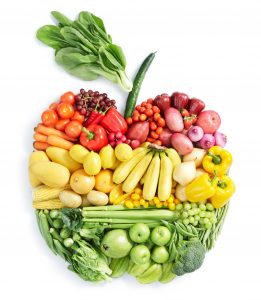
According to a report produced by the Centers for Disease Control (CDC), Americans of all ages do not consume adequate amounts of fruits and vegetables each day. The report states that only 1 out of 10 American adults consume the recommended amount of vegetables each day, while only 2% of high school students meet the guidelines.
1 The
2015-2020 Dietary Guidelines for Americans recommends adults consume 1.5-2 cups of fruits each day and 2-3 cups of vegetables.
2 Fruits and vegetables are rich in vitamins and minerals that are essential to growth and development in children, and with increased consumption, have been shown to protect us from chronic illnesses such as heart disease, type 2 diabetes, obesity, and even some cancers.
1 Listed below are some simple tips to increase fruit and vegetable consumption to live a healthier lifestyle.
Start Early:
- Adding peppers, onions, mushrooms, or spinach to your eggs in the morning is a good way to add flavor to your morning routine and extra vitamins and minerals.
- Combining berries with your plain yogurt will give you an extra serving of fruit along with the benefit of antioxidants.
- Try sweetening you oatmeal or cereal with a banana, berries, or apples instead of adding syrup or sugar.
Consume Often and in a Variety:
- Try to have at least one serving of fruit or vegetables at each meal. Have a side salad with lunch instead of French fries, or a piece of fruit at breakfast instead of toast.
- When making sandwiches for lunch, stuff in some extra spinach and tomatoes or cucumbers and sprouts.
- Instead of eating the same fruits and vegetables each day, become adventurous and try one new fruit or vegetable a week. To make it a family event, find your local Farmer’s Market and allow one person a week to pick out a new item for the family to try. While you are there, ask the vendors how they like to cook and eat different produce to find new ways to enjoy your fruits and vegetables.
Replace Snacks:
- When feeling hungry between meals reach for a fruit or vegetable and pair it with a protein source for a healthy and filling snack. Instead of eating a candy bar during the afternoon, go for some grapes with cheese or celery sticks with peanut butter.
- Keep fresh fruit in a bowl on the counter so you can see what you have available.
- Pack fresh carrot sticks or crunchy bell peppers for a quick snack at work.
- Dried fruits are an excellent option for those busy days, just be mindful of the portion size and look at the nutrition facts label.
Get Creative:
- Replace the oil in baked goods with applesauce or pureed bananas to reduce fat intake.
- Add shredded zucchini or pureed pumpkin to increase moisture content and add nutrients.
- Add frozen vegetables to soups or casseroles for a quick and easy way to increase vegetable consumption.
- Making homemade pizza is a great opportunity to add extra veggies, such as tomatoes, peppers, mushrooms or spinach
- For picky eaters, puree red peppers, carrots, or winter squashes and add them to sauces for a bigger flavor.
- https://www.cdc.gov/nutrition/downloads/fruits-vegetables/2018/2018-frui...
- https://health.gov/dietaryguidelines/2015/resources/2015-2020_Dietary_Gu...
 According to a report produced by the Centers for Disease Control (CDC), Americans of all ages do not consume adequate amounts of fruits and vegetables each day. The report states that only 1 out of 10 American adults consume the recommended amount of vegetables each day, while only 2% of high school students meet the guidelines.1 The 2015-2020 Dietary Guidelines for Americans recommends adults consume 1.5-2 cups of fruits each day and 2-3 cups of vegetables.2 Fruits and vegetables are rich in vitamins and minerals that are essential to growth and development in children, and with increased consumption, have been shown to protect us from chronic illnesses such as heart disease, type 2 diabetes, obesity, and even some cancers.1 Listed below are some simple tips to increase fruit and vegetable consumption to live a healthier lifestyle.
Start Early:
According to a report produced by the Centers for Disease Control (CDC), Americans of all ages do not consume adequate amounts of fruits and vegetables each day. The report states that only 1 out of 10 American adults consume the recommended amount of vegetables each day, while only 2% of high school students meet the guidelines.1 The 2015-2020 Dietary Guidelines for Americans recommends adults consume 1.5-2 cups of fruits each day and 2-3 cups of vegetables.2 Fruits and vegetables are rich in vitamins and minerals that are essential to growth and development in children, and with increased consumption, have been shown to protect us from chronic illnesses such as heart disease, type 2 diabetes, obesity, and even some cancers.1 Listed below are some simple tips to increase fruit and vegetable consumption to live a healthier lifestyle.
Start Early: